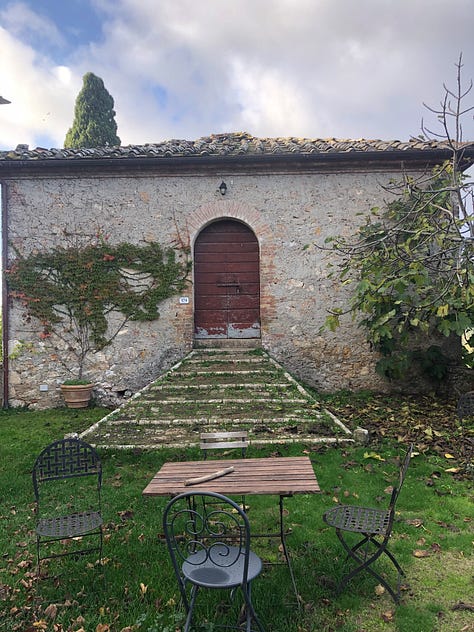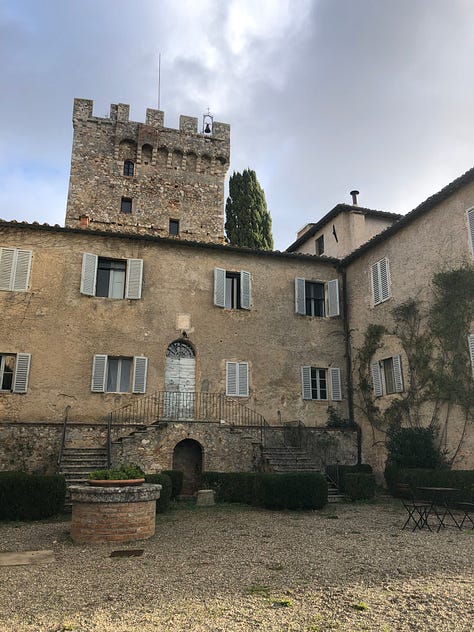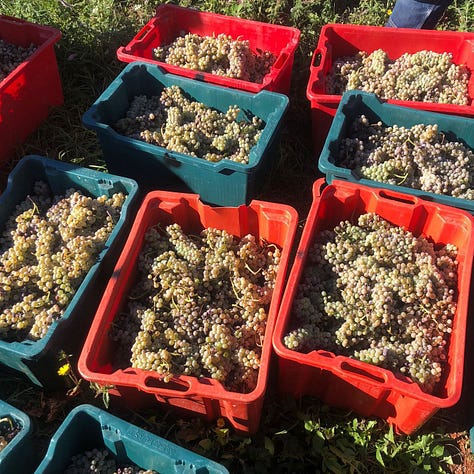Tenuta di Spannocchia
sustainable food systems education in Rosia, Tuscany
If I could go back and tell my 21-year old self to go to Italy and work on a farm instead of a restaurant, I would. Specifically at Tenuta di Spannocchia.
My first trip to the agriturismo + working farm was in August of 2022. The Farm Director, Niccolò and I had been chatting back and forth all summer. He was a vital source of information for my thesis research on the topic of sustainable wine production. I was drawn to Spannocchia because of their sustainable food education program. A field still misunderstood by many in the USA & Italy, but not by Niccolò. He was an alumni of the University of Gastronomic Sciences in Pollenzo.
Tenuta di Spannocchia offers farm internships, apprenticeships and takes volunteers throughout the year. Internships run for about three months, while apprenticeships and volunteer stints can vary in duration. Included in the program is opportunity to engage with the local food economy in the form of field trips to other nearby farms, wineries, breweries or food production facilities. Not to mention all of the incredible meals and lessons learned by eating seasonal, regional recipes.



Tenuta di Spannocchia’s history spans centuries as the property and estate has been passed down through generations. In 1992, grand daughter of owner Delifino, and her American husband, Randall moved to Rosia to restore and revive the property and implement the farm operations which still remain in place today. Their entire history can be read here.
Because I had spent the summer traveling around Italy researching the definition of ‘sustainable wine’ Niccolò thought it would be fun to organize a workshop on the topic of natural vs. conventional wine, especially through my eyes as an American studying wine in Italy. Up until Niccolò’s arrival, Spannocchia had been making wine via conventional techniques - mainly relying on inoculation rather than natural yeasts. They already practiced organic farming methods, and they utilized small production methods like foot-stomping and using a basket press. It was important to Niccolò that the finished product mirror the low-intervention practices already in place.
Per usual it took me three trains and a bus to reach Siena, the closest town to the farm. Niccolò gave me directions to a bus stop in the town of Rosia, where I was to wait until he could pick me up with the car. At this point I was a professional at traveling solo to these very remote wine regions. It was quiet normal for me to wait alone at a bus stop, with only my backpack and my phone at 15 percent.
At the farm, we had a fantastic lunch of pasta with red pepper sauce, side of lentils, tomato salad and grilled vegetables. I never expect lunch, but I am always appreciative when it’s served, especially in Italian fashion, two courses, a large jug of sparkling water and coffee to finish. I was a bit nervous to be giving a presentation, because wine education and working with young people are two passions of mine. I could see myself turning this type of education.workshop. presentation of Italian products thing into a career after graduation.
The workshop went really well! I am never sure if young people, think I am cool and informed, or trying to hard to be relatable. It’s strange for me to be the older one of the group. In Napa, I remember it was only a few years ago I attented a tasting and lunch at Frog’s Leap Winery with my co-workers, when someone made a comment at the table questioning my presence there. They doubted my knowledge of the importance of the wines we were tasting, which were back vintage bottles of Frog’s Leap’s estate Cabernet and the Golden Goose, a 1976 Stag’s Leap Cabernet. For reference, 1976 was year of The Judgement of Paris, and Stag’s Leap 1973 Cabernet was selected as one of the best wines by French and American judges. This wine represented a very important time in Napa Valley history. I knew that before anyone at the table explained it to me, but I let them feel superior. All this to say, I was used to fighting to have my experiences and place at the table validated (I still am). So being invited to lead a workshop on the topic of sustainable wine at an agriturismo in Tuscany, felt pretty good.
After the workshop, we gathered on the terrace for an aperitivo, and I was able to taste the wines they produced at the estate. Reminder: this is before the transition to low-intervention winemaking. The wines tasted hot, like there was an imbalance of alcohol and sweetness. The rosé was stable, but not exciting to drink, in comparison to the other wines I experienced throughout the summer. Then again, tonight was not really about critiquing the quality of the wine, but enjoying the quality of the company.
Over wine, the interns shared their stories of their own travels throughout Italy since their arrival and their hilarious escapades. They showed me photos of them drenched in sweat after climbing the infamous steep staircases on the Amalfi Coast, and the burgers they ate from Dario Cecchini’s panini truck in Panzano. I was inspired by their work and experience in the farming and food world, even before their arrival to Spannocchia. Many had worked at farms in their hometowns, or traveled around the USA as a WWOOF volunteer. I was almost jealous that they involved themselves in the agricultural side of food at such a young age. When I was 23, I was working in restaurants and entertaining guests who claimed to be foodies (cringe). Looking back, I would have much rather endured the incredibly hard work of olive harvesting, than work a Sunday brunch.
Dinner was served outside, and it was the first evening in the summer that felt comfortable in temperature. Comfortable meaning, not sweating while simply standing still. Every guest staying at the tenuta was invited to dinner. Long tables were filled with people and plates of food.
We ate risotto for primi, and for secondi, while the table ate lasagne bolognese, Niccolò graciously went to the kitchen and prepared a plate of cheese, pears and honey for me. I didn’t mention I was vegetarian because I have grown accustomed to filling up on the (usually always veggie-loaded) primi course. The farm interns were ravenous from their day of manual labor in the August sun, and they scarfed down their first and second courses without hesitation. I was so happy to be in the presence of others, who were just as passionate to learn about food and agriculture as I was, so I ate slowly, my plates from each course piling up in front of me. My gift to the group (because you cannot arrive at a home, winery, brewery, without some sort of offering) was a bottle of dessert wine from a winery I had worked at earlier in the summer, Poggio la Noce. The owner, Claire sent me home with a mixed-half-case of their wines. Those six wines were appropriately divvied out to other winemakers, friends and roomates throughout the summer. I decided on a wine the interns assumingly never had before, at least not of this quality, Vin Santo. Poggio la Noce’s Vin Santo, technically, a Vin Santo Occhio di Perniceis, is made almost entirely of Sangiovese grapes (other Vin Santos are made of Trebbiano and/or Malvasia grapes). It paired perfectly with the chocolate torte we had for dessert.
The next day the intern's work schedule included planting onion seedlings and hoeing the garden. I asked if I could come along. Eager to show the farm interns that I can talk the talk and walk to walk (I really wanted them to like me). I grabbed a shovel and got work which meant spreading compost, which was basically all cow manure. Next to the garden, I noticed a row of uninhibited grape vines. I asked Niccolò about them because even though grapes were growing, the vines were visibly untamed and rather selvaggi. He said the vineyard was not being utilized and it had been forgotten for a few years. It was apparent that some of the root stalks had been affected by disease resulting in subpar fruit bunches. I wish I lived nearby so I could adopt the vineyard and help bring it back to life.
I took the car, the bus and the train(s) back to Rome and continued my summer of research. I hoped I left the interns with a few ideas, and inspirations about natural wine, I know I left with a few ideas of my own.
one year later…
Over the years I have tried to keep up my relationships with winemakers, farmers, food people I met during my time in Italy. In The Fall of 2023, I was living and working in Porto and was freelance.helping.working with a friend of mine who organizes and leads craft beer tours around Rome and Italy. I immidiately I thought the new cohort of farm interns at Spannocchia would be a great audience for a potential brewery tour in Tuscany! When I reached out to Niccolò, he explained that they had just recently taken a trip to Cantina Errante, a small brewery focused on spontaneous ferment beers, and barrel aging near Bologna, so while another brewery trip was not necceassry, perhaps I could return to the farm and lead another workshop, this time on the topic of Italian Craft Beer (cue my excitement).
By the time November rolled around, I was living (briefly) in Turin. And I decided to take the long way back to Spannocchia. From Turin I took the train to Bolonga, and then to Modena. Where I booked an Airbnb for two nights. I know, I know basta Airbnb, but as I mentioned before, as a solo female traveler, I prioritze my comfort and safety, this apartment had that and more. I also used the short layover in Modena to explore a few old and new places and pick up craft beers to go alongside my workshop. I bought four beers from one of my go-to wine shops (the one I stop at every time I am Modena) and the other four, I planned to buy at one of the best craft beer stores in Bologna. I also had some questions that I knew the owner would be able to answer. He had been so helpful the previous times I visited.
I took the moring train to Bologna (25 minutes) and arrived before 11:30am. I walked to Il Presto only to find out it was closed, permanently, just for the day, I wasn’t sure. Regardless, I had come to the city to purchase the beers I needed for this workshop. If only more places sold craft beer then I wouldn’t have to travel so far to source them. My contingency plan was to buy beer from my second choice, a craft beer pub called Punto. Luckily for me, it’s deemed normal to buy wine & beer for takeaway from pubs, bars and restaurants. The downside is that I had to wait until they opened at 5:30pm.
Don’t you worry, it all worked out just fine. I spent the day in Bolonga, and made it back to Modena. If you find yourself in either cities these are my recommendations.
Where to EAT, DRINK and WAIT for the train
In an effort to travel as cheap and efficiently as possible (while keeping my sanity) I often find myself waiting for the last train back to Rome. Why? because it’s usually the cheapest, and I see it as an excuse to experience a day away in a new city.
The next day I boarded the train yet again to Bologna, which took me to Florence, from Florence I took another train to Siena. From Siena I took the bus to Rosia. It was great to see Niccolò again, and we shared exciting news from the farm, the new cohort of interns and some of the projects I have been working on.
I have an article coming out soon about the inherent sustainability of Italian craft beer vs. mass-produced beer. So stay tuned for that. In short, your food purchases and habits are a driving force in changing the food system. By choosing craft beer over macro beer you are choosing to support independent breweries, small business, local food supply chains and biodiversity. Again, I’ll have more details later. Here is an article on Italian craft beer I wrote that may help answer some questions.
For the tasting following the workshop, I brought along eight craft beers to try, from a variety of breweries around Central and Northern Italy. This was the line-up. (From left to right) Maso Alto, Ca’ del Brado, Bibibir, Birrificio WAR, Claterna, CRAK, Birra dell’Eremo.
I originally thought I would be able to find at least a few beers from brewries in Lazio, beers I have been drinking for years and know extremely well. But it was also a good excersise for me to think on my feet and execute the best I could with the resources that I had.
I hope to do another one of these craft beer educational workshops when I return to Italy in The Fall (spoiler). So if you or anyone you know works in food systems education, feel free to pass along my info.
Because it was mid November, we had dinner inside, the majority of guests were parents visiting their kids, plus the agriturismo staff. I brought a bottle of wine that I knew Niccolò would enjoy given it was made near his home region of Emilia. Vittorio Graziano’s "Ripa di Sopravento" sparkling Trebbiano and mystery grapes (that’s how the website describes it).
I had been easing my body back into occassionaly eating meat. For dinner we had pasta with kale pesto (primi) and Ossobuco with polenta (secondi), not the easiest transitional meal away from vegetarianism, but I could feel my body welcome the protein.
Remember earlier when I said that Niccolò wanted to change the wine program and practice more natural/low intervention winemaking techniques? Well he and his team accomplished it, and this year (2024) they released their first IGT Bianco, blend of Trebbiano with a little Malvasia, made in the orange wine style. I brought the bottle all the way back to Colorado with me, and paired it with Thanksgiving dinner. The difference between the rosé I had for aperitivo the year before, and this bottle, were night and day. I can’t wait to see how the wine program evolves over the next few years.
In addition to wine, and delicious food, they produce olive oil, and 15 different types of salumi (cured meats) from the animals we raise on the property, including Cinta Senese, a heritage breed of pig from Tuscany. You can read more about their specialty agricultural products here.



There are so many local guides, and digital nomads claiming to be local guides, and conflicting noise when it comes to recommendations of where to stay, eat, drink and play, in Italy. For the responsible travelers reading this, I highly recommend a stay at Tenuta di Spannocchia. The agriturismo offers rooms inside the main villa, and private homes a stone’s throw away form the main property that can accomodate up to ten people. The breakfasts, lunches and dinners I ate there were some of the best meals I had during my time in Italy. I’m not just saying that. It’s the best representation of farm to table, because the orto is visible from the kitchen window.
POST Postscript
If you like what you read, PLEASE subscribe. Knowing that people are electively signing up to read my writing is the biggest compliment and encourages me to write more. I don’t plan on putting up a pay-wall at the moment, but anything helps as far as pledges go! A few generous readers have made an annual pledge and that support means the world to me. It helps me value my writing and my time as important, instead of feeling trapped behind a bar.
Thank you for reading,
Tana








i’m so grateful i stumbled upon this post! i’m hoping to spend more time in italy this summer and will now have to make a trip here. it sounds magical 🫶
A wonderful description of Spannocchia! Our family has spent 5 or 6 vacations there, and your stories of the interns and the food there is perfect.